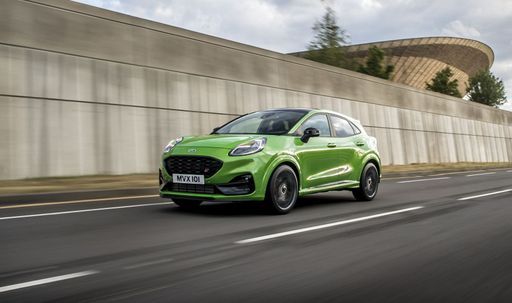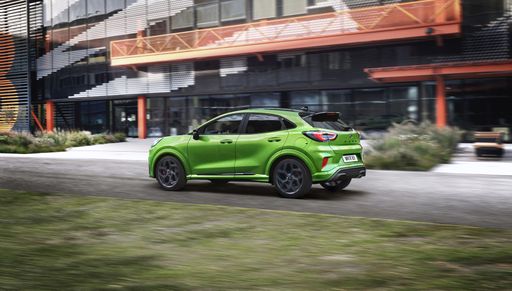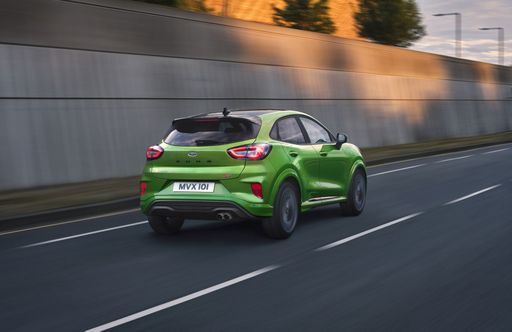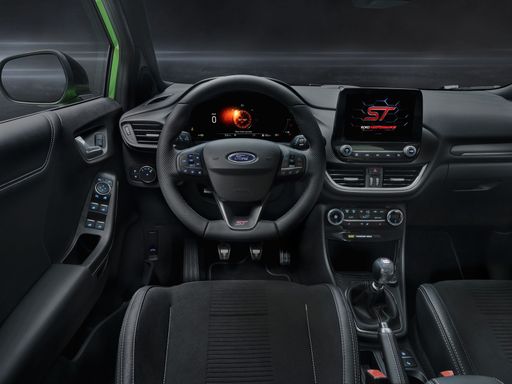Ford Puma vs Ferrari 296 Roadster – Differences & prices compared
Compare performance, boot space, consumption and price in one view.
Find out now: which car is the better choice for you – Ford Puma or Ferrari 296 Roadster?
The Ford Puma (SUV) comes with a Petrol MHEV or Electric engine and Manuel or Automatic transmission. In comparison, the Ferrari 296 Roadster (Roadster) features a Plugin Hybrid engine with Automatic transmission.
When it comes to boot capacity, the Ford Puma offers 523 L, while the Ferrari 296 Roadster provides 0 L – depending on how much space you need. If you’re looking for more power, decide whether the 168 HP of the Ford Puma or the 830 HP of the Ferrari 296 Roadster suits your needs better.
In terms of consumption, the values are 13.10 kWh5.40 L per 100 km for the Ford Puma, and 7.40 L for the Ferrari 296 Roadster.
Price-wise, the Ford Puma starts at 24800 £, while the Ferrari 296 Roadster is available from 266200 £. Compare all the details and find out which model fits your lifestyle best!
Ford Puma
The Ford Puma presents itself as a stylish compact SUV with a distinctive design that combines practicality with a dynamic driving experience. Its sleek lines and sporty aesthetics make it stand out on the road, while the interior offers a comfortable and tech-savvy environment. With an emphasis on efficiency and a smooth drive, the Ford Puma is well-suited for both urban commutes and countryside adventures.
details @ puma.fordpresskits.com
@ puma.fordpresskits.com
 @ puma.fordpresskits.com
@ puma.fordpresskits.com
 @ puma.fordpresskits.com
@ puma.fordpresskits.com
 @ puma.fordpresskits.com
@ puma.fordpresskits.com
Ferrari 296 Roadster
The Ferrari 296 Roadster is a striking addition to the brand's esteemed lineup, offering an exhilarating blend of performance and style. Designed with an emphasis on driving pleasure, this open-top marvel delivers an engaging experience enhanced by its agile handling and responsive dynamics. Its sleek, aerodynamic contours and luxurious interior materials reflect Ferrari's unwavering commitment to craftsmanship and innovation.
details

|
|
|
|
|
Costs and Consumption |
|
|---|---|
|
Price
24800 - 36300 £
|
Price
266200 £
|
|
Consumption L/100km
5.4 - 6 L
|
Consumption L/100km
7.40 L
|
|
Consumption kWh/100km
13.1 - 13.7 kWh
|
Consumption kWh/100km
-
|
|
Electric Range
364 - 376 km
|
Electric Range
25 km
|
|
Battery Capacity
43 kWh
|
Battery Capacity
-
|
|
co2
0 - 136 g/km
|
co2
169 g/km
|
|
Fuel tank capacity
42 L
|
Fuel tank capacity
65 L
|
Dimensions and Body |
|
|---|---|
|
Body Type
SUV
|
Body Type
Roadster
|
|
Seats
5
|
Seats
2
|
|
Doors
5
|
Doors
2
|
|
Curb weight
1316 - 1563 kg
|
Curb weight
1540 kg
|
|
Trunk capacity
456 - 523 L
|
Trunk capacity
0 L
|
|
Length
4186 - 4226 mm
|
Length
4565 mm
|
|
Width
1805 mm
|
Width
1958 mm
|
|
Height
1550 - 1555 mm
|
Height
1191 mm
|
|
Payload
367 - 469 kg
|
Payload
412 kg
|
Engine and Performance |
|
|---|---|
|
Engine Type
Petrol MHEV, Electric
|
Engine Type
Plugin Hybrid
|
|
Transmission
Manuel, Automatic
|
Transmission
Automatic
|
|
Transmission Detail
Manual Gearbox, Dual-Clutch Automatic, Reduction Gearbox
|
Transmission Detail
Dual-Clutch Automatic
|
|
Drive Type
Front-Wheel Drive
|
Drive Type
Rear-Wheel Drive
|
|
Power HP
125 - 168 HP
|
Power HP
830 HP
|
|
Acceleration 0-100km/h
7.4 - 9.8 s
|
Acceleration 0-100km/h
2.90 s
|
|
Max Speed
160 - 210 km/h
|
Max Speed
330 km/h
|
|
Torque
170 - 290 Nm
|
Torque
740 Nm
|
|
Number of Cylinders
3
|
Number of Cylinders
6
|
|
Power kW
92 - 124 kW
|
Power kW
610 kW
|
|
Engine capacity
999 cm3
|
Engine capacity
2992 cm3
|
General |
|
|---|---|
|
Model Year
2024 - 2025
|
Model Year
2022
|
|
CO2 Efficiency Class
D, E, A
|
CO2 Efficiency Class
F
|
|
Brand
Ford
|
Brand
Ferrari
|
Ford Puma
A Glimpse into the Ford Puma: Fusing Style with Innovation
The Ford Puma stands as a testament to modern engineering fused with style. This compact SUV is not just about aesthetics but brings to the table an array of technical innovations, topped with the reliability and performance Ford is known for. Let's delve into the technical specifics and innovative features that make the Ford Puma a stellar choice for any car enthusiast.
Powertrains and Performance
The Ford Puma is offered with a range of powertrains designed to deliver optimal performance whilst minimising fuel consumption. At the heart of this compact SUV is the 1.0 EcoBoost Hybrid engine, available in both 125 PS and 155 PS variants. This engine is a marvel of engineering, optimised to deliver power efficiently with a remarkable fuel consumption ranging from 5.4 to 5.7 L/100km for manual versions, and slightly higher for the automated variants.
The top-end 1.5 EcoBoost ST variant takes performance up a notch, providing a robust 200 PS that propels the Puma from 0 to 100 km/h in just 6.7 seconds. This variant is perfect for those who prioritise performance and exhilaration in their driving experience.
Mild-Hybrid Technology
The Puma's mild-hybrid technology plays a significant role in enhancing fuel efficiency and reducing emissions. By utilising a belt-driven integrated starter/generator, the Puma recovers energy usually lost during braking, storing it in a 48-volt lithium-ion battery. This stored energy is then used to assist the engine, providing a boost during acceleration and smoothing out the stop-start technology, ultimately leading to enhanced fuel efficiency.
Design and Comfort
The Ford Puma does not compromise on style and comfort with its ergonomic and stylish design. The SUV is available in multiple trims including the ST-Line, Titanium, and the luxurious Vignale editions, each offering unique aesthetic and technological enhancements. These trim levels provide varied offerings in terms of both exterior styling and interior comfort, ensuring there's a Puma that meets every personal preference.
Inside, the Puma offers a driver-focused cockpit with advanced technological integrations such as the SYNC 3 infotainment system, providing seamless connectivity and intuitive control of the vehicle's numerous technological features.
Safety and Technology
Safety remains paramount, and the Ford Puma is equipped with the latest security and technology features. It boasts the Ford Co-Pilot360 suite which includes adaptive cruise control, pre-collision assist with autonomous emergency braking, and lane-keeping assist, enabling a safer driving experience on both city roads and highways.
Versatility and Practicality
Beyond performance and safety, the Ford Puma shines in its versatility. With a boot capacity of 456 litres, it offers ample space for all sorts of adventures, whether you're heading on a family trip or loading sports equipment. Its innovative MegaBox is an extra storage solution, providing additional space below the boot floor.
The Puma's agile handling, paired with its compact dimensions—spanning a length of 4186 to 4266 mm and a width of 1805 mm—makes it an ideal choice for urban commuting and beyond.
Conclusion
In conclusion, the Ford Puma beautifully blends practical features with cutting-edge technology, offering a package that appeals to both the tech-savvy driver and those seeking comfort and reliability. Its range of innovative features, powerful yet efficient engine options, and a design that is both functional and stylish make it a frontrunner in the compact SUV market.
Whether you're drawn by the efficient mild-hybrid engines or the robust performance of the ST variant, the Ford Puma represents a modern driving experience where innovation meets everyday usability.
Ferrari 296 Roadster
Experience the Thrill: The New Ferrari 296 Roadster
The Ferrari 296 Roadster is a symbol of elegance and power, representing the pinnacle of Ferrari's automotive engineering. This formidable beast on wheels masterfully combines stunning design with innovative hybrid technology, encapsulating the future of sports cars.
Design and Engineering Excellence
From its striking exterior curves to its plush interiors, the Ferrari 296 Roadster is a testament to Ferrari’s rich heritage in car design innovation. Featuring a compact yet aerodynamic body, the car measures 4,565 mm in length, 1,958 mm in width, and stands 1,191 mm tall. These dimensions give the Roadster an aggressive stance while enhancing its on-road performance.
The seating capacity is strategically limited to two, ensuring a focused, immersive driving experience that keeps tradition alive in modern form.
Powertrain and Performance
Under the sleek hood, the 296 Roadster houses a potent 2992 cm³ V6 engine, coupled with a state-of-the-art Plug-in Hybrid Electric Vehicle (PHEV) system. Together, they deliver an astonishing output of 830 PS (610 kW), demonstrating an outstanding blend of power and efficiency.
The car’s acceleration from 0-100 km/h is a mere 2.9 seconds, propelled by robust torque of 740 Nm. The maximum speed peaks at 330 km/h, ensuring thrill-seekers are not left wanting. The automated dual-clutch transmission, an F1-inspired feature, makes every gear shift smooth and precise.
Efficiency Meets Innovation
Despite its raw power, the Ferrari 296 Roadster remains commendably efficient. It has a fuel consumption rate of 7.4 L/100 km, supported by a slight 25 km electric-only range, reducing its carbon footprint slightly at 169 g/km CO2 emissions.
This efficiency, matched with its high-performance credentials, illustrates Ferrari’s commitment to the hybrid revolution while preserving the thrilling essence of driving.
Pricing and Market Position
The Ferrari 296 Roadster, with a starting price of 310,595 €, secures its stance as a luxury item for the discerning enthusiast. This price tag reflects the advanced engineering and the seamless fusion of luxury and technology.
Conclusion: A New Era for Ferrari
In conclusion, the Ferrari 296 Roadster is more than just a sports car; it is an experience, an epitome of engineering and luxury. Its blend of power and efficiency represents a bold step forward in the high-performance segment, heralding a new era of hybrid supercars that do not compromise on the driving excitement Ferrari is known for.
The prices and data displayed are estimates based on German list prices and may vary by country. This information is not legally binding.
